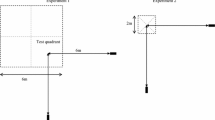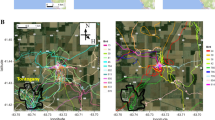Abstract
The memory-based recognition of a goal is a capacity well demonstrated in birds, and understanding this ability often involves determining the relative importance of spatial and feature information in representing the properties of a goal. However, surprisingly little avian research has examined goal recognition in a field setting. Here, we demonstrate that homing pigeons can be successfully trained outdoors to fly to and land on a goal platform located in an array of other platforms at a distance on the order of 100 m. They can do so under conditions when the properties of the goal are stable in time as well as when the properties of the goal periodically change; the latter condition indicating that homing pigeons can rapidly adapt their memory representations to take into account changing environmental conditions. When probed for preferential use of either spatial (location) or feature-based (color) information, the pigeons demonstrated an indifferent capacity to use both independent of task demands. The homing pigeon memory systems that support goal recognition appear to be opportunistic with respect to the information exploited, using spatial and feature information equally to guide their behavior. Therefore, and despite strong natural and artificial selection for navigational ability, spatial information is no more important than feature cues in representing a goal location for homing pigeons flying outdoors.






Similar content being viewed by others
References
Bingman VP, Erichsen JT, Anderson JD, Good MA, Pearce JM (2006) Spared feature-structure discrimination but diminished salience of environmental geometry in hippocampal-lesioned homing pigeons (Columba livia). Behav Neurosci 120:835–841
Brodbeck DR (1994) Memory for spatial and local cues: a comparison of a storing and non-storing species. Anim Learn Behav 22:119–133
Brodbeck DR, Shettleworth SJ (1995) Matching location and color of a compound stimulus. J Exp Psychol Anim Behav Process 21:64–77
Brodbeck DR, Burack OR, Shettleworth SJ (1992) One-trial associative memory in black-capped chickadees. J Exp Psychol Anim Behav Process 18(1):12–21
Cheng K (1986) A purely geometric module in the rat’s spatial representation. Cognition 23:149–178
Chiandetti C, Vallortigara G (2008) Spatial reorientation in large and small enclosures: comparative and developmental perspectives. Cogn Proc 9:229–238
Clayton NS, Krebs JR (1994) Memory for spatial and object-specific cues in food-storing and non-storing birds. J Comp Physiol A 174:371–379
Cristol DA, Reynolds EB, Leclerc JE, Donner AH, Farabaugh CS, Ziegenfus CW (2003) Migratory dark-eyed juncos, (Junco hyemalis), have better spatial memory and denser hippocampal neurons than nonmigratory conspecifics. Anim Behav 66:317–328
Gray ER, Blomfield LL, Ferrey A, Spetch ML, Sturdy CB (2005) Spatial encoding in mountain chickadees: features overshadow geometry. Biol Lett 1:314–317
Hampton RR, Shettleworth SJ (1996) Hippocampus and memory in a food-storing and in a nonstoring bird species. Behav Neurosci 110:946–964
Healy SD, Hurly TA (1998) Rufous hummingbirds’ (Selasphorus rufus) memory for flowers. J Exp Psychol Anim Behav Process 24:396–404
Hermer L, Spelke E (1994) A geometric process for spatial representation in young children. Nature 370:57–59
Hurly TA, Healy SD (1996) Memory for flowers in rufous hummingbirds: Location or local visual cues? Anim Behav 51:1149–1157
Hurly TA, Franz S, Healy SD (2010) Do rufous hummingbirds (Selasphorus rufus) use visual beacons? Anim Cogn 13:377–383
Kahn MC, Bingman VP (2009) Avian hippocampal role in space and content memory. Eur J Neurosci 30:1900–1908
Kamil AC, Jones JE (2000) Geometric rule learning by Clark’s nutcrackers (Nucifraga columbiana). J Exp Psychol Anim Behav Process 26:439–453
Kamil AC, Balda RP, Olson DJ (1994) Performance of four seed-caching corvid species in the radial-arm maze analog. J Comp Psychol 108:385–393
Kelly DM, Spetch ML, Heth CD (1998) Pigeons’ encoding of geometric and featural properties of a spatial environment. J Comp Psychol 112:259–269
Krebs JR, Sherry DF, Healy SD, Perry VH, Vaccarino AL (1989) Hippocampal specialization of food-storing birds. Proc Natl Acad Sci USA 86:1388–1392
Learmonth AE, Nadel L, Newcombe NS (2002) Children’s use of landmarks: implications for modularity theory. Psychol Sci 13:337–341
Lewis JL, Kamil AC (2006) Interference effects in the memory for serially presented locations in clark’s nutcrackers, (Nucifraga columbiana). J Exp Psychol Anim Behav Process 32:407–418
Nardi D, Bingman VP (2007) Asymmetrical participation of the left and right hippocampus for representing environmental geometry in homing pigeons. Behav Brain Res 178:160–171
Pravosudov VV, Clayton NS (2002) A test of the adaptive specialization hypothesis: population differences in caching, memory and the hippocampus in black-capped chickadees (Poecile atricapilla). Behav Neurosci 116:515–522
Pravosudov VV, Kitaysky AS, Omanska A (2006) The relationship between migratory behaviour, memory and the hippocampus: An intraspecific comparison. Proc R Soc B Biol Sci 273:2641–2649
Sherry DF, Schacter DL (1987) The evolution of multiple memory systems. Psychol Rev 94:439–454
Sherry DF, Vaccarino AL, Buckenham K, Hertz RS (1989) The hippocampal complex of food-storing birds. Brain Behav Evol 34:308–317
Spetch ML, Rust TB, Kamil AC, Jones JE (2003) Searching by rules: pigeons’ (Columba livia) landmark-based search according to constant bearing or constant distance. J Comp Psychol 117:123–132
Strasser R, Bingman VP (1996) The relative importance of location and feature cues for homing pigeon (Columba livia) goal recognition. J Comp Psychol 110:77–87
Strasser R, Bingman VP (1997) Goal recognition and hippocampal formation in the homing pigeon (Columba livia). Behav Neurosci 111:1245–1256
Strasser R, Bingman VP (1999) The effects of hippocampal lesions in homing pigeons on a one-trial food association task. J Comp Physiol A 185:583–590
Tinbergen N (1935) Über die Orientierung des Bienenwolfes (Philanthus triangulum Fabr.). Z Vgl Physiol 21:699–716
Vallortigara G (1996) Learning of colour and position cues in domestic chicks: males are better at position, females at colour. Behav Process 36:289–296
Vallortigara G, Feruglio M, Sovrano VA (2005) Reorientation by geometric and landmark information in environments of different size. Develop Sci 8:393–401
Vargas JP, Petruso EJ, Bingman VP (2004) Hippocampal formation is required for geometric navigation in pigeons. Eur J Neurosci 20:1937–1944
Wallraff HG (2005) Avian navigation: pigeon homing as a paradigm. Springer, Berlin
Wiltschko R, Wiltschko W (2003) Avian navigation: from historical to modern times. Anim Behav 65:257–272
Acknowledgments
We wish to thank Robert Beason, Dale Klopfer, Chad Hall and Andy Wickiser for their help with various aspects of this study. Support for the research was provided in part from NSF grant IOS-0922508 to VPB, and we are grateful to NSF for their support. The experiments comply with the laws of the United States and were conducted with the approval of the Bowling Green State University Institutional Animal Care and Use Committee.
Conflict of interest statement
The authors declare that they have no conflict of interest.
Author information
Authors and Affiliations
Corresponding author
Rights and permissions
About this article
Cite this article
Maury, D.L., Mauch, R.J., Hammer, A.N. et al. Spatial and feature-based memory representation in free-flying homing pigeons. Anim Cogn 13, 733–743 (2010). https://doi.org/10.1007/s10071-010-0324-y
Received:
Revised:
Accepted:
Published:
Issue Date:
DOI: https://doi.org/10.1007/s10071-010-0324-y




